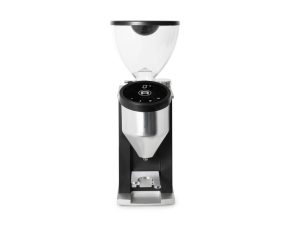So you have chosen the right espresso machine for your needs. How do you choose a grinder to bring out the best that your machine can offer?
Can’t I just get my local to grind my coffee?
If you’re serious about good coffee, we would strongly advise against this. The chances of someone guessing just the perfect grind for your machine? Pretty much zero.
In any event, ground coffee is stale within minutes of being ground, so your money is wasted. Store purchased pre-ground coffee, no matter what the technology used is completely stale. It’s a waste of money!
Supermarket beans? Also stale. You should purchase coffee which is fresh. This means your means have a roast date and should be no more than a couple of weeks old before you start using them.
Conical or flat burrs?
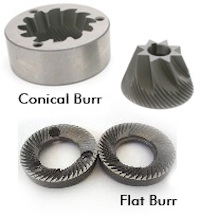 To make things complex, there are two classes of grinder: blade (whirly blade) and burr. Whilst cheap blade grinders are sold as coffee grinders by many department stores, they have little relevance to coffee and should be avoided. Of the burr grinders, there are cheap and expensive conical burr grinders and the flat burr grinders.
To make things complex, there are two classes of grinder: blade (whirly blade) and burr. Whilst cheap blade grinders are sold as coffee grinders by many department stores, they have little relevance to coffee and should be avoided. Of the burr grinders, there are cheap and expensive conical burr grinders and the flat burr grinders.
In order of size, price and performance we consider entry level conical grinders, then flat burr grinders and then finally the large commercial conical burr grinders. Here’s what you will get for your money:
Grinder history
In the years prior to 2000, doser grinders were found in most cafes and the homes of those who were serious about coffee. The limitation of this class of grinders is if the dosing chamber is allowed to fill, the coffee in the doser is likely to become stale within a few minutes. Switched on cafes began grinding through their doser by switching the grinder on only when coffee was required, clicking like crazy until they had a suitable dose and then switching the grinder off. Home users copied the cafes.
Doserless grinders are now much more common and allow for fresh coffee at all times. We find that doser grinders are far less popular given the convenience of doserless grinders and we no longer recommend doser grinders in any application. Nevertheless, we can source Mazzer, Anfim, Compak and Macap doser grinders if required.
Ok, so how much do I need to spend?
We advise that you purchase the best grinder you can afford. It doesn’t make sense to pair a $3000 espresso machine with a $300 grinder and forego shot quality. Contact us to discuss your options. Like all gear, each grinder has its pros and cons and we call them warts and all!
<$100- don’t go there! Whirly blade spice cutters
All very cheap grinders will be “whirly blade” appliances. They create very uneven particle size and are in fact spice grinders. They should be kept for spices!
$100-200: Small conical burr appliances
In this price bracket, you will find the Sunbeam EM series at your local department store. These are barely adequate for espresso and have a limited lifespan. Although they’re the best of a decidedly average bunch, we advise against them. Buy a high quality hand grinder instead. It will give you $3k grinding performance for little more than $100.
$200+: More expensive small conical burr appliances (around 1kg/week)
In this price bracket, you might get by with a Breville Smart Grinder Pro from a department store. It offers convenience and cleanliness but is not really satisfactory for espresso in our opinion. Our most recent (Christmas 2022) experience with a brand new example was sub-standard. It was way too noisy and not capable of producing an espresso grind out of the box unmodified. We rate it marginal at best. Longevity appears to be 2+ years. The conical burrs used in this class have little in common with the big conical grinders and grind quality is nowhere near as good as that found in the more expensive flat burr grinders. Baratza produce their Sette 270 series and we found them to be fast and and capable of good grind quality. These grinders are however quite noisy and many have experienced longevity issues with this brand. We will not sell them. They break.
$400-700. Flat burr small commercial. Manual doserless and single dose. (2-4kg/week)
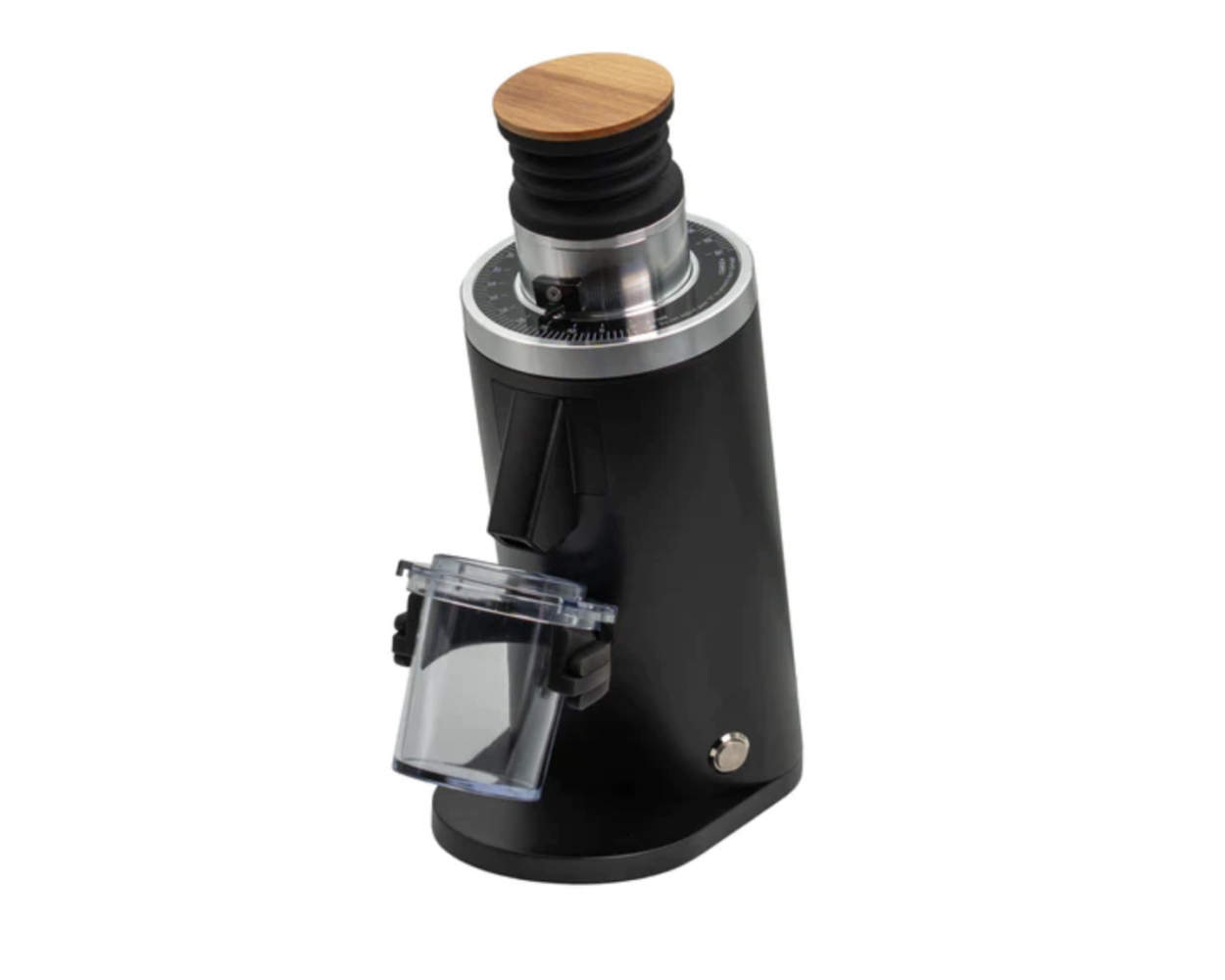 Now we’re talking! At this price point, you are purchasing a grinder which will grind on demand into a dosing cup. Your local cafe may well be using one of these for decaf. These grinders will produce very consistent particle size and with care will last a long, long time. In this price bracket, our pick is the DF54 which offers low retention and outstanding performance. It’s our best buy recommendation in the <$500 class. Grinders in this category are also quite compact- ideal for tight spaces.
Now we’re talking! At this price point, you are purchasing a grinder which will grind on demand into a dosing cup. Your local cafe may well be using one of these for decaf. These grinders will produce very consistent particle size and with care will last a long, long time. In this price bracket, our pick is the DF54 which offers low retention and outstanding performance. It’s our best buy recommendation in the <$500 class. Grinders in this category are also quite compact- ideal for tight spaces.
Circa $800 (or as much as $2500). Doserless and Digital doserless flat burr grinders (2-20kg/week dependent on pricing) and Hihter quality single dose.
These are aspirational grinder for home users. While grind quality is identical to the flat burr grinders above, you purchase the convenience of a digital timer. Set the particle size and then adjust the grind time in 0.1 second increments (or even 0.05 seconds in some variants) for accurate and repeatable dose and shot consistency. Examples include the very quiet to operate Macap Leo 55 and sister Stone Espresso Pebble, the Rocket Espresso Fausto and Rocket Espresso Faustino 3.1. and Giannino. We also really like the Anfim Luna which is a rebadged Mahlkonig E65S.
Circa $1000 to $2500. Single dosing flat burr grinders
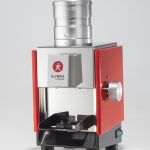 We rate the Olympia Express Moca SD and also the DF 64 Gen 2 , DF83V, DF64V Gen II and Acaia Orbit.
We rate the Olympia Express Moca SD and also the DF 64 Gen 2 , DF83V, DF64V Gen II and Acaia Orbit.
Circa $1700 to $5000. Large conical burr electronic doserless. (>20kg/week)
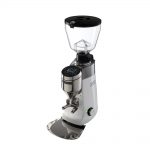 In this price bracket, we switch back to conical burrs but it’s not a case of the same grind quality as the cheapies. These big, very fast grinders run large burr sets and need big motors and powerful gearboxes to operate them. The burrs rotate more slowly than those of flat burr grinders. Grind quality improves incrementally- but mainly for those who prefer black coffee in that they can contribute to improved shot quality. This is generally undetectable under milk. You’d have to be very serious about your coffee! In addition, they generally retain more coffee in the throat between the burrs and the dosing spout or chamber than smaller grinders. This can be of concern to some home users as it may lead to some wastage. Great examples include the Mazzer the Kony S Electronic and Mazzer Robur S Electronic which we can source to order. You will be grinding at 4-6 seconds per double shot with these monsters.
In this price bracket, we switch back to conical burrs but it’s not a case of the same grind quality as the cheapies. These big, very fast grinders run large burr sets and need big motors and powerful gearboxes to operate them. The burrs rotate more slowly than those of flat burr grinders. Grind quality improves incrementally- but mainly for those who prefer black coffee in that they can contribute to improved shot quality. This is generally undetectable under milk. You’d have to be very serious about your coffee! In addition, they generally retain more coffee in the throat between the burrs and the dosing spout or chamber than smaller grinders. This can be of concern to some home users as it may lead to some wastage. Great examples include the Mazzer the Kony S Electronic and Mazzer Robur S Electronic which we can source to order. You will be grinding at 4-6 seconds per double shot with these monsters.
Circa $3500 to >$5000. Large, including grind by weight, super flat burr, manual bag grinders and electronic doserless grinders. (>20kg/week and specialty applications)
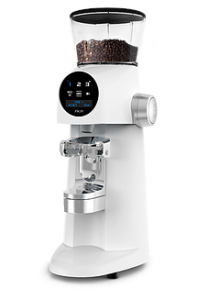 This group includes the top end flat burr grinders which are in vogue in many specialty cafes. They’re quick and expensive. Whilst some are designed for espresso, others were originally designed as commercial bag grinders and are repurposed by some cafes for regular espresso duty. Commonly seen manual versions include the Mahlkonig EK43 and EK43S.
This group includes the top end flat burr grinders which are in vogue in many specialty cafes. They’re quick and expensive. Whilst some are designed for espresso, others were originally designed as commercial bag grinders and are repurposed by some cafes for regular espresso duty. Commonly seen manual versions include the Mahlkonig EK43 and EK43S.
Grind by weight?
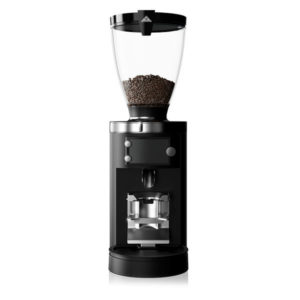 These are game-changers! The Mahlkonig E65S GBW is our current favourite and our big budget recommendation in this category is the larger and faster E80S GBW which is an incredible grinder.
These are game-changers! The Mahlkonig E65S GBW is our current favourite and our big budget recommendation in this category is the larger and faster E80S GBW which is an incredible grinder.
Hand grinders?
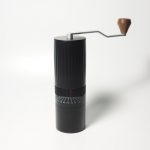 There are inexpensive small hand grinders such as those manufactured by Hario and Rhinowares, but we can’t recommend these for espresso as they are either too slow or there is far too much variation in particle size at espresso grind. Longevity can also be questionable. They are however suitable for many manual methods of producing coffee. Far better hand grinders which employ commercial quality conical burr sets will do the espresso job brilliantly- albeit with a good workout for those arms. All of these great hand grinders solve many, if not all of the deficiencies of the cheaper hand grinders and offer large conical burr grind quality.
There are inexpensive small hand grinders such as those manufactured by Hario and Rhinowares, but we can’t recommend these for espresso as they are either too slow or there is far too much variation in particle size at espresso grind. Longevity can also be questionable. They are however suitable for many manual methods of producing coffee. Far better hand grinders which employ commercial quality conical burr sets will do the espresso job brilliantly- albeit with a good workout for those arms. All of these great hand grinders solve many, if not all of the deficiencies of the cheaper hand grinders and offer large conical burr grind quality.
In conclusion
Ultimately it comes down to your individual circumstances, but we do advise that you buy the best grinder you can afford for your machine. It’s wiser to save a few hundred dollars on an espresso machine and then allocate the savings to a better grinder rather than to compromise your enjoyment in the cup.
